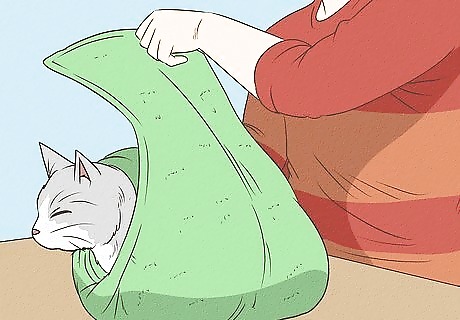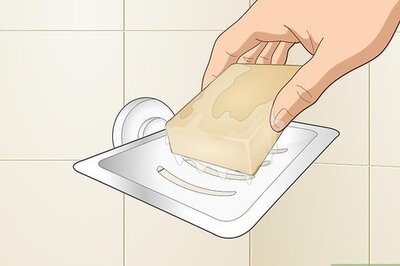
views
Giving the Cat the Nose Drops

Point the cat’s nose towards the ceiling. If you are right handed, use your left hand and make a "C" shape with your thumb and forefinger. Place your thumb under the cat's jaw, and your forefinger on their forehead. The cat's head should now be held in your hand. Hold the cat's head gently and twist your wrist so that the nose is rotated upward to point towards the ceiling.

Position the bottle of drops. Pick up the bottle of nose drops in your dominant hand. You should already have removed the lid in preparation. If you have not already removed the lid of the bottle, let go of the cat's head, remove the lid and start again.

Squeeze the bottle. Holding the dropper bottle between your finger and thumb, invert the bottle such that the dropper is pointing towards the floor. Give the bottle a gentle squeeze until a drop of liquid appears at the end of the nozzle. Maintain this pressure and position the dropper nipple as close to the cat's nostril as possible. Once you are happy with the position of the bottle, squeeze the bottle until the required number of drops are dispensed into the cat's nostril.

Bring the bottle a little closer. The exact distance of the dropper nipple is not crucial, but the closer you are to the nose the more likely it is that the drop will go into the nostril. In an ideal world, you should touch the nipple to the nostril, but some cats will flinch away when they feel the bottle’s touch, which will make you lose the positioning of your bottle. Try to hold the bottle so that it hovers about two to three millimeters above the entrance to your cat’s nostril so that the drop is most likely to go in.
Restraining Your Cat

Understand why it is important to restrain your cat. When your cat with faced with an unknown substance, such as nose drops, they may become skittish, which is why they will need to be restrained. However, keep in mind that you should always be gentle with your cat; do not shout at them or scold them, even if they do not cooperate. If you act gently and compassionately, your cat may still be unhappy, but will be less likely to run away from the medication in the future.

Gather everything you need. Whether you choose to use an assistant or simply tackle the matter yourself, you will need several items before you can begin. It helps to gather these items before you begin the drop-applying process so that the process can run more smoothly. You will need: A table: Working at a table will make giving your cat the nose drops much easier. Protect the surface of the table from scratching claws with a thick towel. Good lighting : The cat's nose is small and you will need good lighting to see where to position the nozzle of the drops. Nose drops: Read the label and keep store them correctly; many drops need to be stored at 28 °C (82 °F) and away from light. When it is time to administer the drops, have them within hand's reach and remove the lid in anticipation of application. A large towel: A towel is handy for method one (two people) if you cat tends to strike out and scratch. The towel is essential for method two (one person) because you need it to wrap the cat up.

Understand that this method of restraint requires two people. You will need an assistant to hold the cat while you administer the drops. This method is generally a little less stressful for your cat, and allows you to have both hands free to administer the drops efficiently. This is generally the preferred method for medicating an aggressive cat. The disadvantage is that it is not always easy to have two people available at the same time the cat is around to give them their medication.

Prepare the table. Cover the table with a towel to create a non-slip surface. Make sure that you have the drops within hand’s reach from the table, and that the top of the drops has been removed.

Have your assistant pick up the cat and bring her to the table. Have your assistant pick up the cat. Bring the cat over to the table, and set her down on the table, but do not have your assistant release her. Have the assistant place the cat on the table with the cat's head facing your dominant hand.

Get your assistant to restrain the cat by standing behind them and placing one hand on each of the cat's arms, just below the elbow (left hand to left arm, right hand to right shoulder). Curl the fingers around the arm so as to maintain a firm grip on the front legs, sufficient to stop the cat from lifting a leg or swiping at you. It also helps to steady the cat if the assistant presses inwards with their forearms so that they lie pressed along the cat's chest and rump. This stops the cat from wriggling side-to-side. With a particularly wriggly cat, the assistant should lean over the cat and use his chest pressed over the cat's back to stop her from jumping upwards. Thus confined the cat cannot run forwards (the hands of the arms stop this), wriggle sideways (the forearms act as restraining bars) or up (the assistant's chest stops this) but their head is free and facing outwards. Note: If the cat is particularly spiteful and determined to lash out, you may need to wrap the cat in a towel (see the next method) and then have the assistant hold the cat.

Understand the concept behind using a towel. This method involves wrapping the cat in a towel so that they are enclosed in a cocoon with her head sticking out. This enables you to then tuck the wrapped cat between your thighs so that you have both hands free to administer the drops. The wrapping process is described in the following steps.

Speak calmly to the cat and pick them up with both hands, cradling their weight in your arms. The towel should have a longer length and narrower width. Place the cat centrally on the towel, at a right-angle to the length, with their nose touching one edge. Let the cat rest on their belly in a natural crouching position, with their paws underneath. There should be an equal length of towel on either side of the cat’s body.

Grip the cat’s scruff. If you are right handed, use your left hand to grip the cat’s scruff. This area of loose skin over the shoulders is where a mother cats holds her kittens to trigger a passive reaction. Although you may feel reticent about gripping your pet firmly, be assured you are not hurting or harming her in any way.

Make the first fold of the towel. To make the first fold, grasp the towel edge your dominant hand so that your hand is about 8 to 10 inches (20.3 to 25.4 cm) from the cat. Apply firm tension to the fabric and fold it right-over-left across the cat’s back, and include the hand restraining the cat in the wrap. You will remove your hand after the next step.

Pick the cat up. Gently lift the cat by the scruff, such that her body is raised at a 45 degree angle to the horizontal, with her bottom resting on the floor and her forequarters elevated. Feed the fold of towel lying across her back, under her left front paw. Then lower her paws back to the tabletop so that her body weight anchors this first wrap in place.

Make the second fold. To make the second fold, grasp the towel on the left side of the cat with your left hand still encased. As before, apply firm tension as you cross the fabric left-to-right over the cat’s back. The cat should now be enclosed in a towel cocoon with just her head sticking out.

Free your left hand. Let go of her scruff and wriggle your fingers free of the wrap. If you applied the correct tension to the towel, the cat’s limbs will remain firmly held against her body.

Place your newly freed hand under the cat’s chest. Lift their front end up off the flat surface so that her body is angled at about 45 degrees to the horizontal. Now use your right hand to grasp the trailing edge of the second wrap, feed it under the cat and pull it firmly so they are tightly swaddled. Continue to wrap the remaining length of towel around the cat until the free length is used up.

Create the final fold. The cat is now rolled in a towel but, if determined, they could wriggle out backwards. The final, or ‘burrito’ fold, involves tucking the final dangling width of the towel under the body. Simply lift up their wrapped rear end and tuck the dangling tail of fabric beneath them. Now when you lower their back end down, their body weight pins the towel beneath them and there is no backwards escape route.

Put the wrapped cat on the table. With the cat wrapped, place them on the table and tuck the cocoon under your arm.


















Comments
0 comment